Abstract
Six male subjects were exposed for two hours during light physical exercise to 2.81 mmol/m3 (293 mg/m3) of styrene on one occasion and to a mixture of 2.89 mmol/m3 (301 mg/m3) of styrene and 21.3 mmol/m3 (1240 mg/m3) of acetone on another (combination study). About 68% of the dose (somewhat more than 4 mmol) of styrene was taken up. The arterial blood concentration of styrene reached a relatively stable level after about 75 minutes of exposure of about 18 and 20 mumol/l after the single and combined exposure, respectively. Calculated values of mean blood clearance were 1.9 l/min in the styrene study and 1.6 l/min in the combination study; the half life of styrene in blood was about 40 minutes in both studies. The concentration of non-conjugated styrene glycol increased linearly during exposure and reached about 3 mumol/l at the end of exposure and was eliminated with a half life of about 70 minutes. Styrene-7,8-oxide was detected and quantified in the blood in a complementary study. The half lives for the excretion of mandelic and phenylglyoxylic acid in the urine were about four and nine hours, respectively, in both studies.
Full text
PDF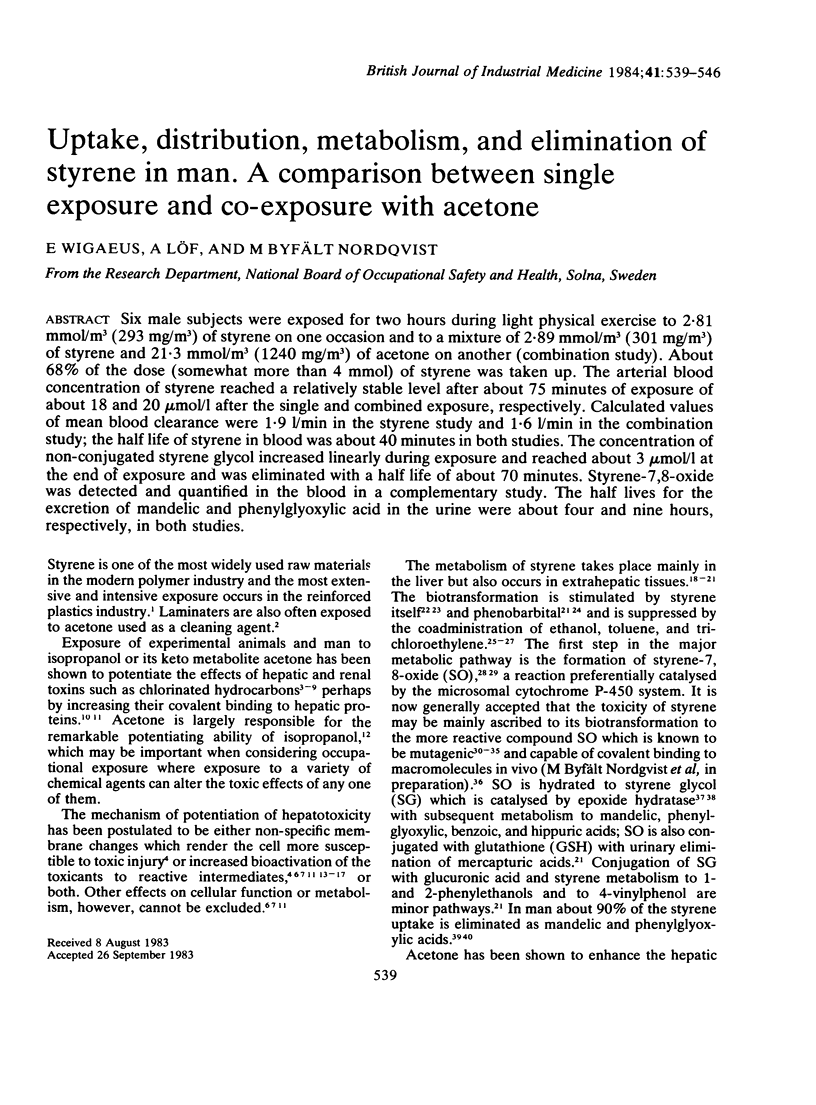


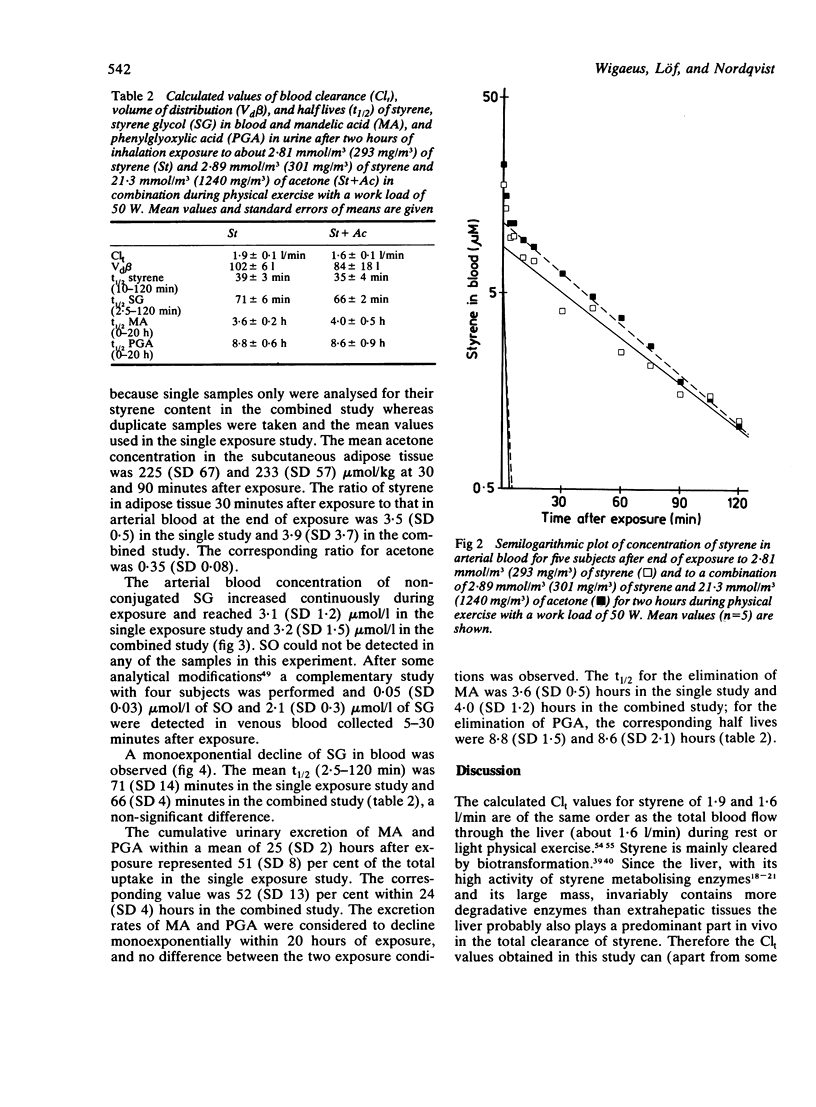
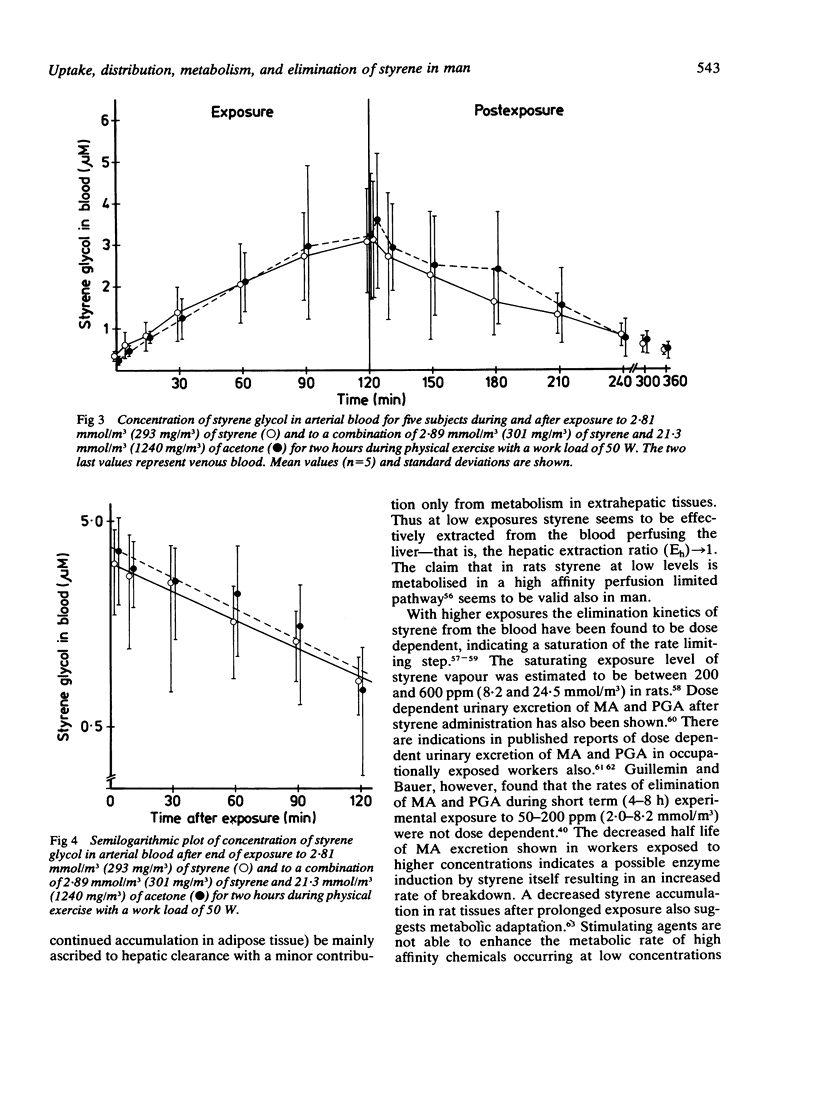
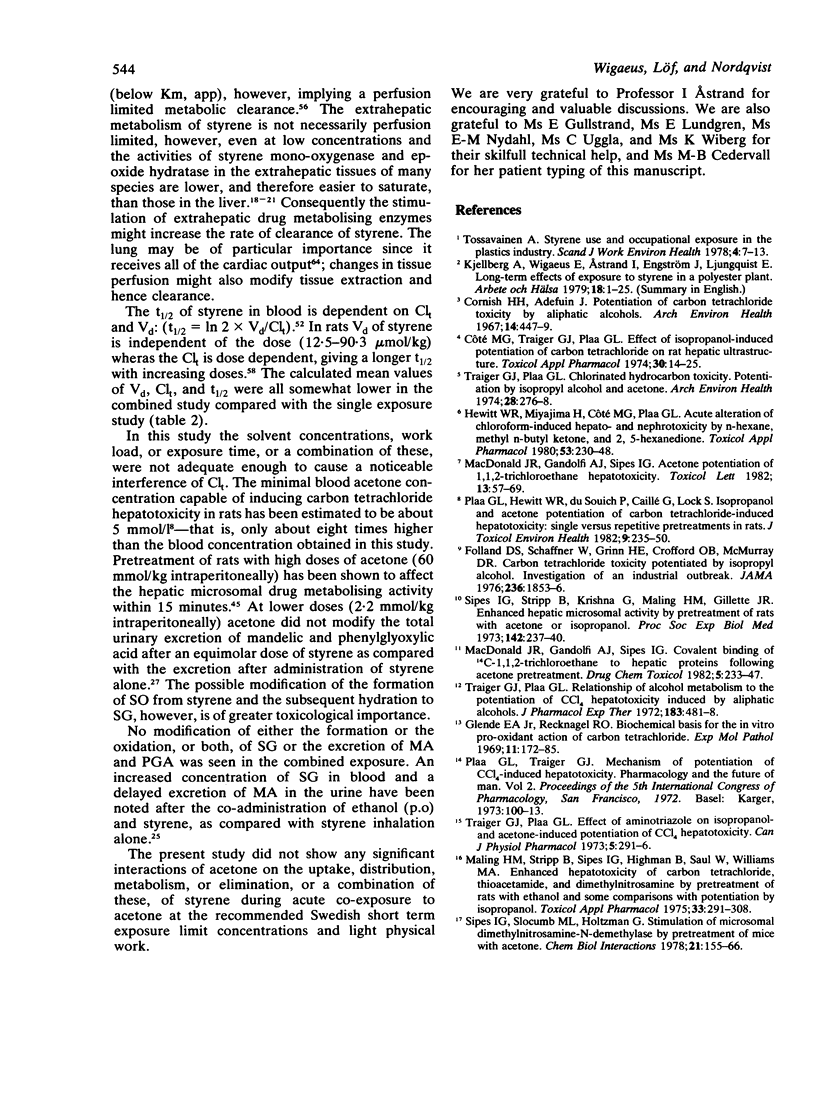
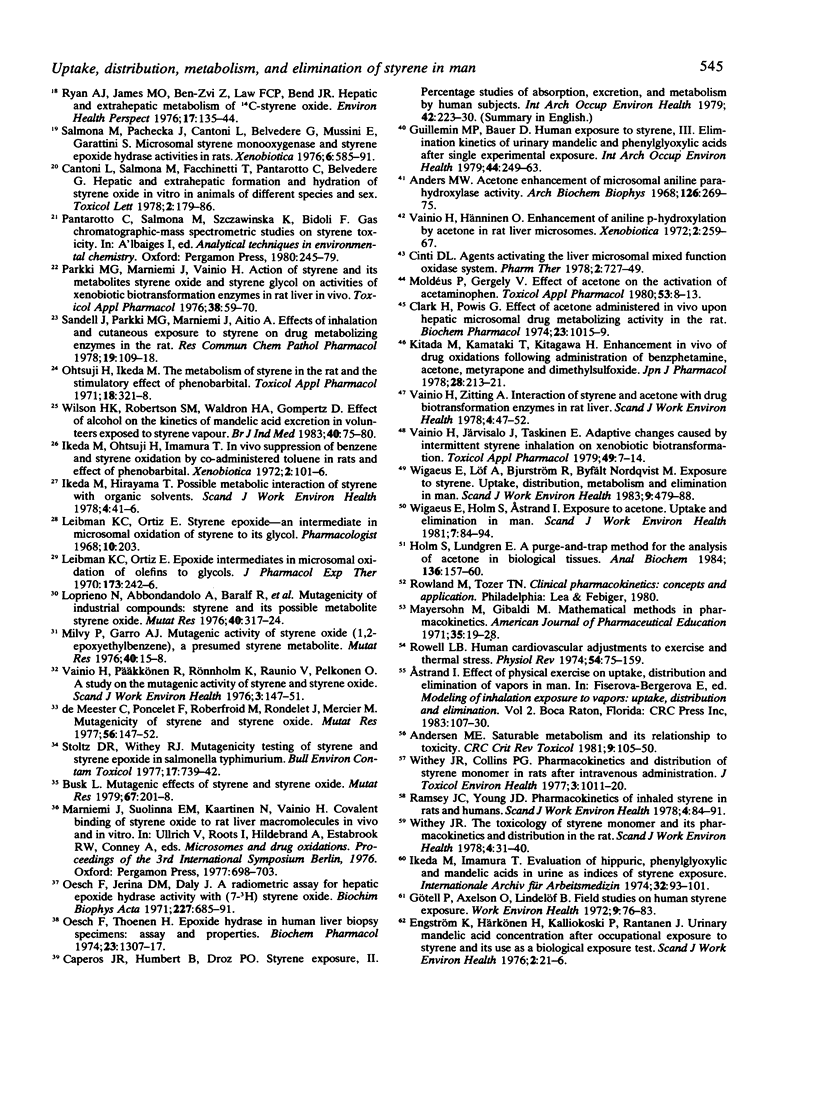
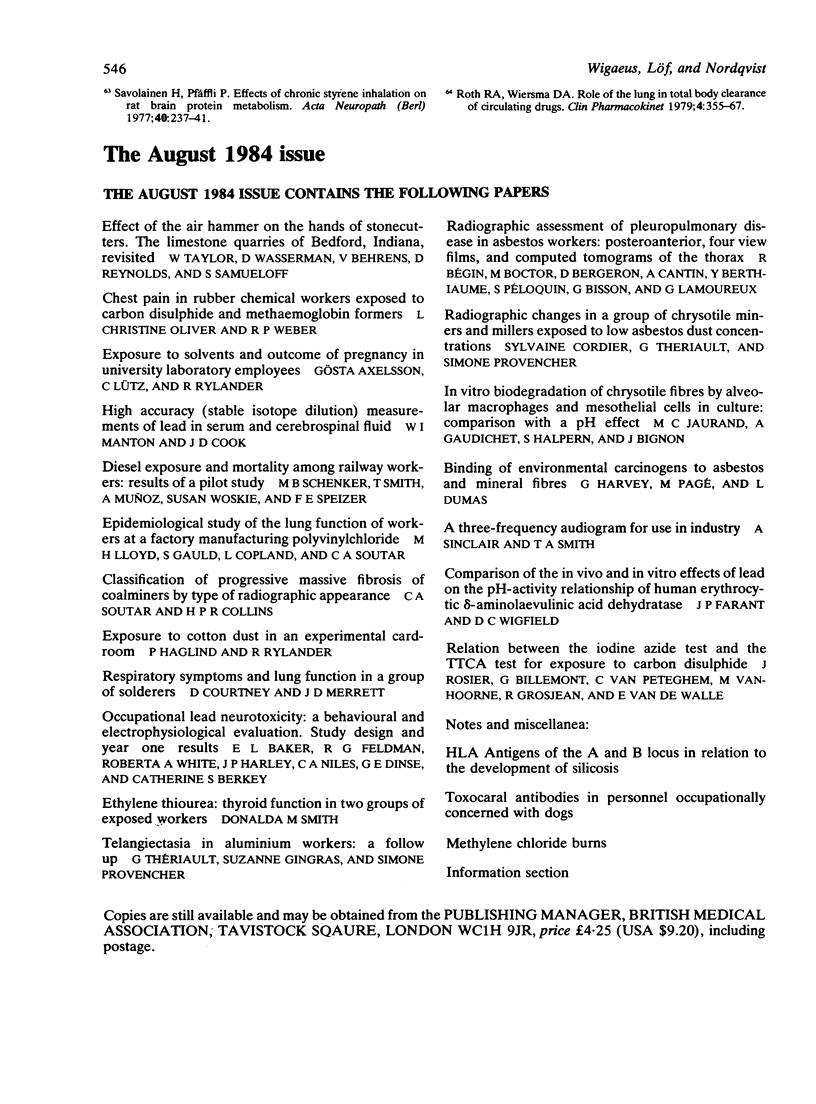
Selected References
These references are in PubMed. This may not be the complete list of references from this article.
- Anders M. W. Acetone enhancement of microsomal aniline para-hydroxylase activity. Arch Biochem Biophys. 1968 Jul;126(1):269–275. doi: 10.1016/0003-9861(68)90583-3. [DOI] [PubMed] [Google Scholar]
- Andersen M. E. Saturable metabolism and its relationship to toxicity. Crit Rev Toxicol. 1981 May;9(2):105–150. doi: 10.3109/10408448109059563. [DOI] [PubMed] [Google Scholar]
- Caperos J. R., Humbert B., Droz P. O. Exposition au styrène. II. Bilan de l'absorption, de l'excrétion et du métabolisme sur des sujets Humains. Int Arch Occup Environ Health. 1979 Jan 15;42(3-4):223–230. doi: 10.1007/BF00377776. [DOI] [PubMed] [Google Scholar]
- Clark H., Powis G. Effect of acetone administered in vivo upon hepatic microsomal drug metabolizing activity in the rat. Biochem Pharmacol. 1974 Mar 1;23(5):1015–1019. doi: 10.1016/0006-2952(74)90031-8. [DOI] [PubMed] [Google Scholar]
- Cornish H. H., Adefuin J. Potentiation of carbon tetrachloride toxicity by aliphatic alcohols. Arch Environ Health. 1967 Mar;14(3):447–449. doi: 10.1080/00039896.1967.10664767. [DOI] [PubMed] [Google Scholar]
- Folland D. S., Schaffner W., Ginn H. E., Crofford O. B., McMurray D. R. Carbon tetrachloride toxicity potentiated by isopropyl alcohol. Investigation of an industrial outbreak. JAMA. 1976 Oct 18;236(16):1853–1856. [PubMed] [Google Scholar]
- Glende E. A., Jr, Recknagel R. O. Biochemical basis for the in vitro pro-oxidant action of carbon tetrachloride. Exp Mol Pathol. 1969 Oct;11(2):172–185. doi: 10.1016/0014-4800(69)90006-9. [DOI] [PubMed] [Google Scholar]
- Guillemin M. P., Bauer D. Human exposure to styrene. III. Elimination kinetics of urinary mandelic and phenylglyoxylic acids after single experimental exposure. Int Arch Occup Environ Health. 1979 Nov;44(4):249–263. doi: 10.1007/BF00381658. [DOI] [PubMed] [Google Scholar]
- Hewitt W. R., Miyajima H., Côté M. G., Plaa G. L. Acute alteration of chloroform-induced hepato- and nephrotoxicity by n-hexane, methyl n-butyl ketone, and 2,5-hexanedione. Toxicol Appl Pharmacol. 1980 Apr;53(2):230–248. doi: 10.1016/0041-008x(80)90423-8. [DOI] [PubMed] [Google Scholar]
- Holm S., Lundgren E. A purge-and-trap method for the analysis of acetone in biological tissues. Anal Biochem. 1984 Jan;136(1):157–160. doi: 10.1016/0003-2697(84)90317-8. [DOI] [PubMed] [Google Scholar]
- Ikeda M., Hirayama T. Possible metabolic interaction of styrene with organic solvents. Scand J Work Environ Health. 1978;4 (Suppl 2):41–46. [PubMed] [Google Scholar]
- Ikeda M., Imamura T., Hayaskh M., Tabuchi T., Hara I. Evaluation of hippuric, phenylglyoxylic and mandelic acids in urine as indices of styrene exposure. Int Arch Arbeitsmed. 1974;32(1):93–101. doi: 10.1007/BF00539099. [DOI] [PubMed] [Google Scholar]
- Ikeda M., Otsuji H., Imamura T. In vivo suppression of benzene and styrene oxidation by co-administered toluene in rats and effects of phenobarbital. Xenobiotica. 1972 Mar;2(2):101–106. doi: 10.3109/00498257209111041. [DOI] [PubMed] [Google Scholar]
- Kitada M., Kamataki T., Kitagawa H. Enhancement in vivo of drug oxidations following administration of benzphetamine, acetone, metyrapone and dimethylsulfoxide. Jpn J Pharmacol. 1978 Apr;28(2):213–221. doi: 10.1254/jjp.28.213. [DOI] [PubMed] [Google Scholar]
- Leibman K. C., Ortiz E. Epoxide intermediates in microsomal oxidation of olefins to glycols. J Pharmacol Exp Ther. 1970 Jun;173(2):242–246. [PubMed] [Google Scholar]
- Loprieno N., Abbondandolo A., Barale R., Baroncelli S., Bonatti S., Bronzetti G., Cammellini A., Corsi C., Corti G., Frezza D. Mutagenicity of industrial compounds: styrene and its possible metabolite styrene oxide. Mutat Res. 1976 Nov;40(4):317–324. doi: 10.1016/0165-1218(76)90030-6. [DOI] [PubMed] [Google Scholar]
- MacDonald J. R., Gandolfi A. J., Sipes I. G. Acetone potentiation of 1,1,2-trichloroethane hepatotoxicity. Toxicol Lett. 1982 Sep;13(1-2):57–69. doi: 10.1016/0378-4274(82)90139-4. [DOI] [PubMed] [Google Scholar]
- MacDonald J. R., Gandolfi A. J., Sipes I. G. Covalent binding of 14C-1,1,2-trichloroethane to hepatic proteins following acetone pretreatment. Drug Chem Toxicol. 1982;5(3):233–247. doi: 10.3109/01480548209041055. [DOI] [PubMed] [Google Scholar]
- Maling H. M., Stripp B., Sipes I. G., Highman B., Saul W., Williams M. A. Enhanced hepatotoxicity of carbon tetrachloride, thioacetamide, and dimethylnitrosamine by pretreatment of rats with ethanol and some comparisons with potentiation by isopropanol. Toxicol Appl Pharmacol. 1975 Aug;33(2):291–308. doi: 10.1016/0041-008x(75)90096-4. [DOI] [PubMed] [Google Scholar]
- Milvy P., Garro A. J. Mutagenic activity of styrene oxide (1,2-epoxyethylbenzene), a presumed styrene metabolite. Mutat Res. 1976 Jan;40(1):15–18. doi: 10.1016/0165-1218(76)90017-3. [DOI] [PubMed] [Google Scholar]
- Moldéus P., Gergely V. Effect of acetone on the activation of acetaminophen. Toxicol Appl Pharmacol. 1980 Mar 30;53(1):8–13. doi: 10.1016/0041-008x(80)90374-9. [DOI] [PubMed] [Google Scholar]
- Oesch E., Jerina D. M., Daly J. A radiometric assay for hepatic epoxide hydrase activity with [7-3H] styrene oxide. Biochim Biophys Acta. 1971 Mar 10;227(3):685–691. doi: 10.1016/0005-2744(71)90017-9. [DOI] [PubMed] [Google Scholar]
- Oesch F., Thoenen H., Fahrlaender H. Epoxide hydrase in human liver biopsy specimens: assay and properties. Biochem Pharmacol. 1974 Apr 15;23(8):1307–1317. doi: 10.1016/0006-2952(74)90333-5. [DOI] [PubMed] [Google Scholar]
- Otsuji H., Ikeda M. The metabolism of styrene in the rat and the stimulatory effect of phenobarbital. Toxicol Appl Pharmacol. 1971 Feb;18(2):321–328. doi: 10.1016/0041-008x(71)90123-2. [DOI] [PubMed] [Google Scholar]
- Parkki M. G., Marniemi J., Vainio H. Action of styrene and its metabolites sytrene oxide and styrene glycol on activities of xenobiotic biotransformation enzymes in rat liver in vivo. Toxicol Appl Pharmacol. 1976 Oct;38(1):59–70. doi: 10.1016/0041-008x(76)90160-5. [DOI] [PubMed] [Google Scholar]
- Plaa G. L., Hewitt W. R., du Souich P., Caillé G., Lock S. Isopropanol and acetone potentiation of carbon tetrachloride-induced hepatotoxicity: single versus repetitive pretreatments in rats. J Toxicol Environ Health. 1982 Feb;9(2):235–250. doi: 10.1080/15287398209530158. [DOI] [PubMed] [Google Scholar]
- Ramsey J. C., Young J. D. Pharmacokinetics of inhaled styrene in rats and humans. Scand J Work Environ Health. 1978;4 (Suppl 2):84–91. [PubMed] [Google Scholar]
- Roth R. A., Wiersma D. A. Role of the lung in total body clearance of circulating drugs. Clin Pharmacokinet. 1979 Sep-Oct;4(5):355–367. doi: 10.2165/00003088-197904050-00002. [DOI] [PubMed] [Google Scholar]
- Rowell L. B. Human cardiovascular adjustments to exercise and thermal stress. Physiol Rev. 1974 Jan;54(1):75–159. doi: 10.1152/physrev.1974.54.1.75. [DOI] [PubMed] [Google Scholar]
- Ryan A. J., James M. O., Ben-Zvi Z., Law F. C., Bend J. R. Hepatic and extrahepatic metabolism of 14C-styrene oxide. Environ Health Perspect. 1976 Oct;17:135–144. doi: 10.1289/ehp.7617135. [DOI] [PMC free article] [PubMed] [Google Scholar]
- Salmona M., Pachecka J., Cantoni L., Belvedere G., Mussini E., Garattini S. Microsomal styrene mono-oxygenase and styrene epoxide hydrase activities in rats. Xenobiotica. 1976 Oct;6(10):585–591. doi: 10.3109/00498257609151671. [DOI] [PubMed] [Google Scholar]
- Sandell J., Parkki M. G., Marniemi J., Aitio A. Effects of inhalation and cutaneous exposure to styrene on drug metabolizing enzymes in the rat. Res Commun Chem Pathol Pharmacol. 1978 Jan;19(1):109–118. [PubMed] [Google Scholar]
- Sipes I. G., Slocumb M. L., Holtzman G. Stimulation of microsomal dimethylnitrosamine-N-demethylase by pretreatment of mice with acetone. Chem Biol Interact. 1978 Jun;21(2-3):155–166. doi: 10.1016/0009-2797(78)90016-9. [DOI] [PubMed] [Google Scholar]
- Sipes I. G., Stripp B., Krishna G., Maling H. M., Gillette J. R. Enhanced hepatic microsomal activity by pretreatment of rats with acetone or isopropanol. Proc Soc Exp Biol Med. 1973 Jan;142(1):237–240. doi: 10.3181/00379727-142-36996. [DOI] [PubMed] [Google Scholar]
- Stoltz D. R., Whitey R. J. Mutagenicity testing of styrene and styrene epoxide in Salmonella typhimurium. Bull Environ Contam Toxicol. 1977 Jun;17(6):739–742. doi: 10.1007/BF01685963. [DOI] [PubMed] [Google Scholar]
- Tossavainen A. Styrene use and occupational exposure in the plastics industry. Scand J Work Environ Health. 1978;4 (Suppl 2):7–13. [PubMed] [Google Scholar]
- Traiger G. J., Plaa G. L. Chlorinated hydrocarbon toxicity. Potentiation by isopropyl alcohol and acetone. Arch Environ Health. 1974 May;28(5):276–278. doi: 10.1080/00039896.1974.10666486. [DOI] [PubMed] [Google Scholar]
- Traiger G. J., Plaa G. L. Effect of aminotriazole on isopropanol- and acetone-induced potentiation of CCl 4 hepatotoxicity. Can J Physiol Pharmacol. 1973 Apr;51(4):291–296. doi: 10.1139/y73-043. [DOI] [PubMed] [Google Scholar]
- Traiger G. J., Plaa G. L. Relationship of alcohol metabolism to the potentiation of CCl 4 hepatotoxicity induced by aliphatic alcohols. J Pharmacol Exp Ther. 1972 Dec;183(3):481–488. [PubMed] [Google Scholar]
- Vainio H., Hänninen O. Enhancement of aniline p-hydroxylation by acetone in rat liver microsomes. Xenobiotica. 1972 May;2(3):259–267. doi: 10.3109/00498257209111056. [DOI] [PubMed] [Google Scholar]
- Vainio H., Järvisalo J., Taskinen E. Adaptive changes caused by intermittent styrene inhalation on xenobiotic biotransformation. Toxicol Appl Pharmacol. 1979 Jun 15;49(1):7–14. doi: 10.1016/0041-008x(79)90270-9. [DOI] [PubMed] [Google Scholar]
- Vainio H., Päkkönen R., Rönnholm K., Raunio V., Pelkonen O. A study on the mutagenic activity of styrene and styrene oxide. Scand J Work Environ Health. 1976 Sep;2(3):147–151. doi: 10.5271/sjweh.2813. [DOI] [PubMed] [Google Scholar]
- Vainio H., Zitting A. Interaction of styrene and acetone with drug biotransformation enzymes in rat liver. Scand J Work Environ Health. 1978;4 (Suppl 2):47–52. [PubMed] [Google Scholar]
- Wigaeus E., Holm S., Astrand I. Exposure to acetone. Uptake and elimination in man. Scand J Work Environ Health. 1981 Jun;7(2):84–94. doi: 10.5271/sjweh.2561. [DOI] [PubMed] [Google Scholar]
- Wigaeus E., Löf A., Bjurström R., Nordqvist M. B. Exposure to styrene. Uptake, distribution, metabolism and elimination in man. Scand J Work Environ Health. 1983 Dec;9(6):479–488. doi: 10.5271/sjweh.2385. [DOI] [PubMed] [Google Scholar]
- Wilson H. K., Robertson S. M., Waldron H. A., Gompertz D. Effect of alcohol on the kinetics of mandelic acid excretion in volunteers exposed to styrene vapour. Br J Ind Med. 1983 Feb;40(1):75–80. doi: 10.1136/oem.40.1.75. [DOI] [PMC free article] [PubMed] [Google Scholar]
- Withey J. R., Collins P. G. Pharmacokinetics and distribution of styrene monomer in rats after intravenous administration. J Toxicol Environ Health. 1977 Dec;3(5-6):1011–1020. doi: 10.1080/15287397709529635. [DOI] [PubMed] [Google Scholar]
- Withey J. R. The toxicology of styrene monomer and its pharmacokinetics and distribution in the rat. Scand J Work Environ Health. 1978;4 (Suppl 2):31–40. [PubMed] [Google Scholar]


